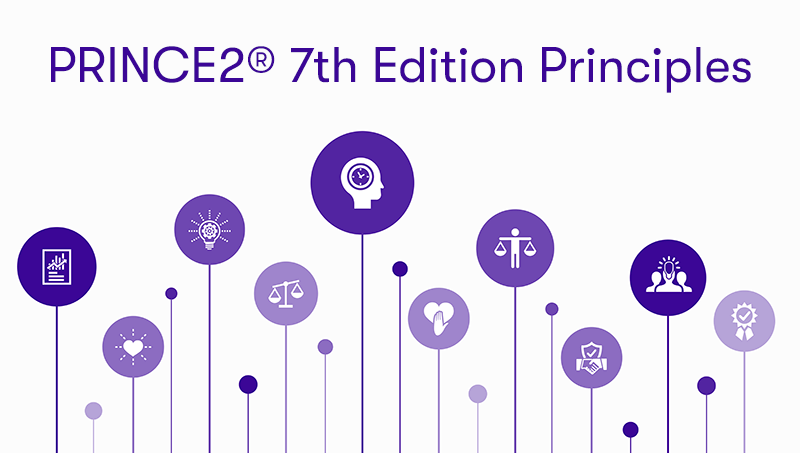PRINCE2® 7th Edition Principles
In the realm of project management, PRINCE2 stands as a formidable framework with universal applicability. Its potency lies in its adaptability, enabling tailored implementation to suit project context, scale, delivery method, and more.
In this blog we will reveal how PRINCE2's 7 principles empower successful project execution through strategic customisation, upholding integrity and relevance.
For more information on PRINCE2 7th Edition, why not check out our PRINCE2® Foundation (7th Edition) Course.
What are Principles?

Principles regarding PRINCE2 are the guiding obligations that determine whether a project is genuinely being managed by PRINCE2, and ensure effective application and tailoring towards the PRINCE2 project.
PRINCE2 is universally suitable for projects of all kinds, encompassing variations in size, intricacy, significance, risk level, and approach to execution (be it linear-sequential, iterative-incremental, or hybrid). Furthermore, its applicability extends to diverse organisational structures, including commercial, governmental, non-profit, and not-for-profit entities. This adaptability holds true worldwide, as PRINCE2 accommodates regional regulations, business frameworks, and cultural factors.
To accommodate such a broad project spectrum, PRINCE2 demonstrates versatility in its application. Instead of dictating specific actions for aligning the method with each project's specifics, PRINCE2 provides guidance through foundational principles. These principles empower the project management team to determine the tailored utilisation of PRINCE2 in their particular project context.
What are the 7th Edition Principles?
There are 7 principles in PRINCE2 7th Edition:
- Ensure continued business justification
- Learn from experience
- Define roles, responsibilities, and relationships
- Manage by stages
- Manage by exception
- Focus on products
- Tailor to suit the project
How these principles are applied and tailored depends on internal and external factors to your organisation as well as the nature of the project.
PRINCE2® 7th Edition Principles

The seven principles grant adaptability by furnishing direction on how the method's interwoven components can be employed and customised to achieve the most suitable approach for the project and its circumstances, all while upholding the method's fundamental integrity. As long as these principles are adhered to, the effective utilisation of PRINCE2 is ensured.
Ensure Continued Business Justification
The commencement of any project necessitates a valid and defensible rationale, a principle that must persistently endure scrutiny throughout the project's entire lifecycle. This underlying justification, rooted in business imperatives, guides the decision-making process to ensure unwavering alignment with sought-after benefits and the broader organisational objectives.
Organisations that overlook the necessity of rigorous business justification might inadvertently witness the progression of projects with scant real advantages or tenuous connections to the overarching business strategy. A misalignment of this nature can culminate in a project portfolio characterised by discordant or duplicated aims, undermining the efficiency and efficacy of the organisation's endeavours.
Even projects compelled by external factors like legal requirements or regulations are not exempt from the mandate of justification. This practice remains vital to ascertain that the chosen approach optimises the allocation of resources. All participants engaged in the project must maintain equilibrium among anticipated benefits, costs, and inherent risks to substantiate their involvement with business justification.
Given the dynamic nature of business landscapes, it's imperative to acknowledge the potential for shifts in the business justification for a project. Thus, it becomes paramount for the project's deliverables to consistently align with this evolving rationale. Should it become untenable to continue with a project, its cessation in a controlled manner stands as a proactive measure. Such a decision serves the greater good of the organisation, liberating funds and resources for redirection towards more promising undertakings.
Post-project culmination, a comprehensive evaluation comes into play, assessing whether the benefits have indeed materialised to a degree that justifies the final investment. Additionally, this post-mortem assessment presents a valuable opportunity to extract insights and lessons from the project experience.
In essence, the principle of upholding a justifiable premise from the inception to the conclusion of a project is a cornerstone. It safeguards against aimless ventures, ensuring projects stay purpose-driven, intimately linked to organisational ambitions, and perpetually poised to deliver tangible value.
Learn From Experience
An inherent trait of projects lies in their distinctive nature, often presenting a challenge due to the unfamiliarity of the temporary team with a project of similar kind. Navigating these challenges requires project teams to explore avenues for gleaning insights from others' experiences as well as from the evolving project itself.
The bedrock of this learning process rests upon data and its capacity to yield insights. Projects should establish clarity regarding the necessary data, the methods for analysis to derive actionable insights, and the handling of data throughout the project's duration and closure.
Efficient dissemination of lessons within the project team is crucial, recognising the varied learning preferences and needs of individuals. Some thrive on observational learning, while others grasp concepts through experiential exploration.
To perpetuate growth and innovation, it's imperative to draw wisdom from both missteps and accomplishments. The onus lies on all involved parties to identify and internalise lessons, rather than relying on others to do so. Lessons that fail to trigger enhancements in the current or future projects remain mere 'identified lessons,' falling short of the status of 'learned lessons.'
Define Roles, Responsibilities, and Relationships
Projects rely on human involvement. Ensuring that the right individuals are engaged and comprehend their expectations and the anticipated reciprocation among project members is vital. Successful projects are underpinned by a profound awareness of stakeholder dynamics and ongoing efforts to fortify these interactions. This rationale substantiates why 'People' stands as one of the five interconnected elements in PRINCE2.
Stakeholders encompass both internal and external entities affiliated with the business. Internal stakeholders span from employee councils, sustainability boards, diversity committees, ownership representatives, department heads, to other project teams. External stakeholders encompass trade unions, clientele, suppliers, communities, interest associations, financial institutions, and media entities.
All projects feature three primary stakeholders: the business itself, users, and suppliers. Effectively representing the interests of these three entities within the project management team is imperative.
The intricacies of defining roles and responsibilities escalate due to projects being cross-functional, frequently involving multiple organisations, a blend of full-time and part-time contributors, and potential geographical dispersion. The managing structures of involved parties likely vary, driven by distinct priorities, objectives, and vested interests. The conventional day-to-day business hierarchy might not inherently accommodate the intricacies of project undertakings.
Assigning roles to individuals throughout the project's lifespan mandates precision, clarity, and mutual acceptance. The crux of success rests on a well-defined project management team structure, encompassing explicit and mutually agreed-upon roles and responsibilities for all project participants. Moreover, these projects must foster a comprehension of interrelationships and establish effective communication pathways between stakeholders.
The overarching aim is to lucidly elucidate roles and responsibilities, thereby constructing a coherent framework that all stakeholders comprehend. This framework must be optimally suited to ensure efficient project execution, aligned with predetermined performance targets.
Manage by Stages
PRINCE2 facilitates effective governance by clearly delineating responsibilities for project direction, management, and execution, while also establishing distinct lines of accountability at each hierarchical level.
This accountability is established through a dual mechanism:
- Firstly, by vesting authority from one management echelon to the next, delineated by setting defined thresholds across the seven performance aspects—benefits, cost, time, quality, scope, sustainability, and risk—for each specific level.
- Secondly, through the creation of controls that raise exceptions should these tolerances be anticipated to be breached. These exceptions are promptly escalated to the subsequent management tier for deliberation on the appropriate course of action.
- Moreover, a mechanism of assurance is instituted to assure each management tier of the efficacy of these exception controls.
Implementing the 'manage by exception' principle optimises senior management involvement. It alleviates their time burden while retaining their oversight. This ensures decisions are made at the apt organisational level. The objective is to provide early alerts to the ensuing management tier in the project if deviations from agreed-upon tolerances are foreseen, necessitating a verdict on whether and how to proceed. The decision-maker can elect to accept the deviation and its repercussions or take measures to mitigate or eliminate it.
In instances where a project follows an iterative-incremental delivery approach with stipulated timeboxes, time and cost parameters are typically rigid, while scope remains adaptable. Consequently, more stringent tolerances are set for time and cost compared to scope.
Manage by Exception
Emphasis on stage-based management ensures the proper initiation of a project before engaging in the delivery of its outputs. Each PRINCE2 project should encompass a minimum of two stages: an initiation phase followed by at least one additional stage. For many projects, the benefits extend beyond this minimum threshold. The merits of adopting a stage-centric approach encompass:
- Flexibility to respond to shifts in project or business context.
- Integration of review and decision junctures, granting the project board opportunities to assess project viability at specific intervals, preventing uncontrolled progression.
- Establishment of pivotal decisions before delving into the intricate implementation details.
- Capacity to ascertain the implications of external influences, such as budget allocations or emerging regulations.
- Facilitation of the manage by exception principle by delegating authority to the project manager for each stage.
The choice of suitable stages for a project hinges on diverse factors which encompass:
- Minimisation of risk exposure across the project lifecycle.
- Project scale and intricacy (shorter stages offer heightened control, whereas longer stages ease senior management involvement).
- Significance of decisions and control checkpoints during the project lifecycle, often tied to key investments, business strategies, or technical determinations.
- Industry or organisational policies and standards.
Sequentially, the project board authorises one stage at a time, empowering the project manager with day-to-day control within agreed-upon limits for that stage. As long as the projected course remains within tolerances, the project manager can make necessary adjustments. The subsequent stage only garners authorisation if there's substantiated business rationale and adequate funding for continuation. Should the project's business case falter, the project board deliberates recovery strategies or potential early termination.
Focus on Products
Projects that centre their attention on the project's deliverables are more likely to achieve efficiency and circumvent unnecessary wastage than projects that predominantly concentrate on the operational tasks. This stems from the fundamental purpose of a project, which revolves around meeting stakeholder expectations while adhering to the business rationale. Consequently, a shared comprehension of the anticipated products and the desired quality levels from the user's perspective is indispensable.
Without a clear and explicit understanding of the envisioned products and the specific criteria by which they will be evaluated and approved, the project's purpose can be subject to various interpretations. PRINCE2 mandates an approach that prioritises outputs over tasks, denoting these outputs as 'products'. In this paradigm, an output-oriented project outlines and defines the project's end product before embarking on the necessary activities to generate it. This cluster of agreed-upon products establishes the project's scope and serves as the foundation for planning and management.
Within the PRINCE2 framework, project descriptions are formulated as product descriptions. These descriptions serve as tools for estimating efforts, discerning resource requisites, identifying dependencies, and structuring activity schedules. The emphasis on products seamlessly aligns with nearly every facet of PRINCE2, encompassing planning, role allocation, progress tracking, quality assurance, change management, acceptance procedures, and risk mitigation.
Tailor to Suit the Project
PRINCE2 offers universal value as a project management methodology that can be adapted to accommodate the specific context, scope, delivery method, stakeholder landscape, complexity, significance, team proficiency, and risk level of any project. Moreover, it is versatile enough to be applicable across a diverse array of project types, geographical locations, and cultural contexts. The strength of its applicability emerges from its innate flexibility to align with each project's distinct requirements and circumstances.
The rationale behind tailoring PRINCE2 is twofold:
- Ensuring alignment of the project management methodology with the project's characteristics, such as harmonising with governing business processes like human resources, finance, and procurement.
- Tailoring project controls to align with the project's scale, intricacy, significance, delivery method, team capability, and risk profile—examples being the frequency and formality of reports and reviews.
Tailoring necessitates proactive decision-making by both the project board and the project manager regarding how PRINCE2's principles will be applied. This process may involve adjusting terminologies to match those of the involved organisations or substituting certain PRINCE2 techniques with existing business or supplier procedures.
During tailoring, it's crucial to recognise that effective project management hinges on acquiring relevant information and making informed decisions.
Neglecting tailoring can lead to mismatched project management efforts and approaches—ranging from overly rigid adherence to PRINCE2 to underwhelming application. Conversely, effective tailoring ensures the methodology's congruence with the project's needs and its principles, avoiding undue rigidity or excessive flexibility.
The project manager bears the responsibility of tailoring, informed by lessons learned and established standards. The project board holds accountability, necessitating approval of recommendations at the initiation stage's end and for proposed management approach changes.
The particulars of how PRINCE2 is to be applied and tailored for a specific project are documented in the project initiation documentation. This document guarantees a comprehensive understanding among all project participants regarding the utilisation of PRINCE2 and the execution of their responsibilities. It's imperative that the proposed tailoring maintains alignment with PRINCE2's 7 principles and upholds the method's overall integrity.
What are the Benefits of PRINCE2 7th Edition Principles?

The key benefits of the PRINCE2 7th Edition Principles are:
Efficiency and Waste Avoidance
Focusing on project deliverables rather than tasks enhances efficiency and minimises waste, ensuring that projects fulfil stakeholder expectations effectively.
Adaptability
Tailoring PRINCE2 to specific project contexts allows projects to be customised to accommodate varying factors such as scale, complexity, and risk, making them more adaptable to changes.
Review and Decision Points
Stage-based management provides defined intervals for project reviews, allowing the project board to assess project viability and make informed decisions, preventing uncontrolled progression.
Key Decision Clarification
The stage-based approach ensures that critical decisions are made before detailed implementation, minimising uncertainties and potential deviations.
External Influences Management
Stage-based planning enables the project to anticipate and address the impact of external factors, like budget processes or legal changes, in a controlled manner.
Effective Control
Empowering the project manager within defined tolerances for each stage enhances control, facilitating timely adjustments to ensure the project remains within desired parameters.
Scope Definition and Planning
Agreeing upon project products before initiating activities provides a clear scope for the project and serves as a basis for planning and management.
Supporting Various Aspects of PRINCE2
An output-oriented approach aligns seamlessly with various aspects of PRINCE2, including planning, responsibilities, progress reporting, quality assurance, change control, acceptance, and risk management.
Alignment with Business Needs
Tailoring PRINCE2 to the specific project context ensures that project management efforts and approaches align with the unique requirements of each project, avoiding excessive rigidity or laxity.
Effective Communication and Coordination
Documenting how PRINCE2 is applied and tailored in project initiation documentation ensures that all project participants understand their roles and responsibilities, fostering effective communication and coordination.
Maintaining Integrity
Tailoring is executed while preserving PRINCE2's seven principles, maintaining the method's fundamental integrity even as it's customised to suit specific project demands.
Final Notes on PRINCE2 7th Edition Principles

In conclusion, the principles of PRINCE2 offer a robust framework for effective project management. Centred on efficiency, these principles champion adaptability, structured reviews, and clarity in decision-making. They advocate for an output-centric approach, emphasising the essence of deliverables over mere tasks. Tailoring this methodology to fit unique project needs ensures it remains flexible while retaining its core tenets. By defining and managing the project's scope, PRINCE2 supports varied facets of project management from planning to risk assessment. In essence, PRINCE2's principles, when tailored appropriately, align with business necessities, facilitate effective communication, and uphold the methodology's foundational integrity, ensuring successful project outcomes.


